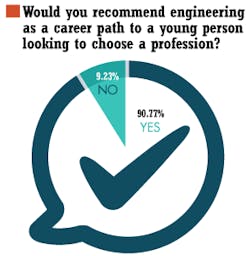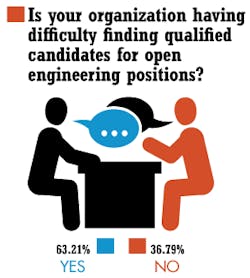Despite a global pandemic, a broken supply chain and a continuing difficulty hiring the next generation of workers, the business of fluid power remained remarkably fluid in 2021.
That’s the key finding in the 2021 Hydraulic & Pneumatics Salary & Career Survey, which polled readers from around the U.S. on topics ranging from compensation to COVID to the next generation of technologies. Even after two years of uncertainty in the overall manufacturing landscape, the fluid power industry remains stable and focused on overcoming the near-term challenges.
Some of that is born of experience: 33.5% of respondents to the Salary & Career Survey have at least 30 years of experience in the industry and 24% have been at their current company for at least 20 years. They also like their jobs and career choice: 83% described themselves as at least satisfied with their job and almost 20% say they are extremely satisfied.
A large reason for this is their fundamental enthusiasm for their work. “Engineering and engineers rule the world—this is what I have learned throughout my college life and my personal life,” one respondent wrote. “Even though we are engineers we have many opportunities to prove ourselves.”
And another wrote, “There is no bigger satisfaction than seeing a machine working smoothly and getting the work done that you have designed and manufactured from scratch. It's the only force getting me out of bed every morning.”
But he added, “And my wife yelling to shut my alarm also plays a major role.”
Professional Satisfaction
Most engineers surveyed love the work they do. Two-thirds said they would not consider leaving the profession, and 91% would recommend the work to a young person looking for a career.
One reason is a bullish outlook on growth in the coming year. The survey found that 41% of respondents expect their company to add engineering jobs in the next year, while half say their company will maintain current engineering levels. Just 13% describe themselves as actively seeking another job, while almost 35% said they cannot imagine looking for work elsewhere.
But there are recognized challenges. The most significant is the need to replace an aging workforce, and 62% of those surveyed agree there is a shortage of engineers. That matches almost exactly the age of the workforce: 59% of respondents are 50 or older, and 31% are 60 or older. On top of that, 63% of the respondents said their company is having difficulty finding qualified workers.
The search for qualified candidates cuts across several disciplines, but respondents noted that engineers for systems engineering, mechanical design, machine learning/artificial intelligence and software were among the most sought-after fields of expertise.
If the mix between traditional and cutting-edge technologies are being sought, there has been somewhat slower adoption of new technologies. Sensors and tech equipment are two of the more utilized recent innovations mentioned by respondents, but only 30% said they had an impact on their design plans—the highest among any technology mentioned.
Areas such as wireless networking, power management and software are other areas of some interest, but when asked about implementing technology, 27% said "None of the Above."
One respondent noted, “We need more brain workers or engineers to improve everything…let go of old ways, methods and products and give way to cheaper, faster and economical to produce.”
Salary and overall compensation remain key drivers of workplace satisfaction, and even in this area there is a general sense that their pay is mostly in line with expectations. Among the survey findings:
- 71% said that salary and career prospects are as promising as they were five years ago
- 62.5% describe their salary as at least competitive in the industry
- 23% describe their compensation as more competitive
- 58% said they are adequately compensated for the work they do.
While compensation is one of the drivers that would initiate a career change from engineering, it’s not the only consideration. While 54.3% said making more money might get them to look outside engineering for another job, 42.9% it could be the chance to do something different and 40% said it would be because of a lack of an opportunity for advancement.
While you would expect a wide salary range in such a survey that stretches across the country, the majority of salaries fell between $60,000 and $150,000, with 46% of respondents reporting they made between $100,000 and $150,000 and 20.5% stating they made between $80,000 and $100,000. And while 29.8% report receiving no bonuses, 30.1% said their bonus ranged up to $5,000, 21.5% said the bonus was between $5,000 and $10,000 and 18% said it was greater than $10,000.
There’s even wider optimism about pay increases for the coming year, with 27.7% expecting a raise of up to 3% in 2022 and 25% expecting pay will increase by at least 4%. Just 12.1% are expecting a pay decrease in the new year.
Problem-Solving Satisfaction
While compensation rewards the Hydraulics & Pneumatics reader, it is the work itself that brings the greatest satisfaction. Part of understanding that satisfaction is a clear-eyed look at the issues they face each day.
The single greatest issues that keep an engineer up at night don’t resolve around compensation or job security, but focus on solving the problems they face each day. The availability of components in a time of tight supply chains was the top concern at 34.9%, but issues such as product reliability issues (31.8%), product deadlines (29.2%), product quality issues (28.2%) and staying current with emerging technologies (24.1%) also were cited by respondents.
That problem-solving attitude has personal and professional rewards, readers noted.
“In the purest form, it is quite satisfying to turn your efforts into a working solution,” one respondent wrote.
“Engineering has the basic concepts of every field at its core,” said another reader. “When you understand a field from its basics, applying the knowledge in the real world becomes easy.”
About the Author
Bob Vavra
Senior Content Director, Power & Motion and Machine Design
Bob Vavra is the Senior Content Director of Power & Motion and its sister publication Machine Design. Vavra has had a long career in publishing, media and events. He has covered all aspects of manufacturing for the past 20 years and is a regular attendee at events such as IMTS and Hannover Messe. Vavra is also a sought-after webcast moderator and event emcee, and has presided over events in the U.S., Germany and China.

Leaders relevant to this article:










